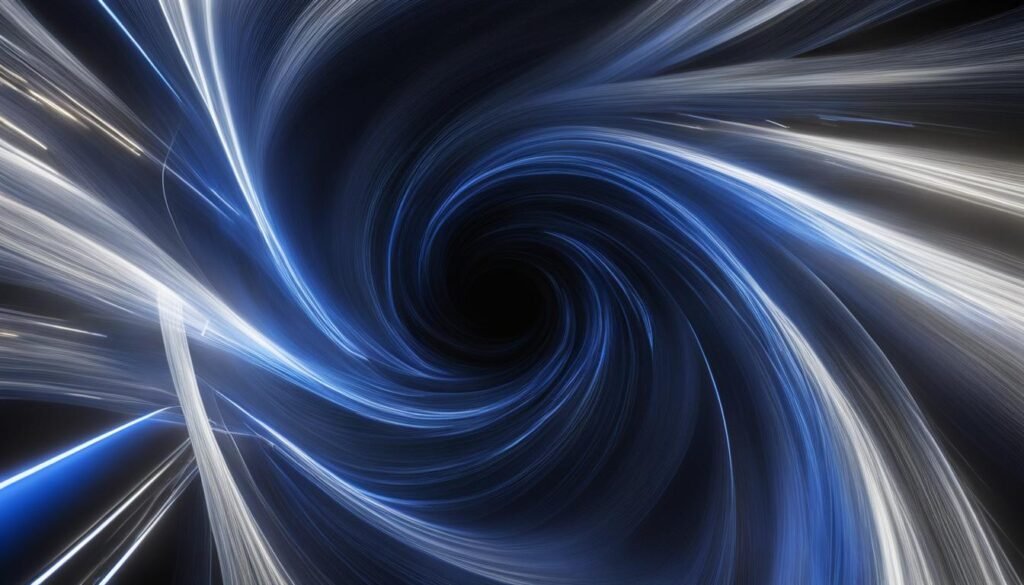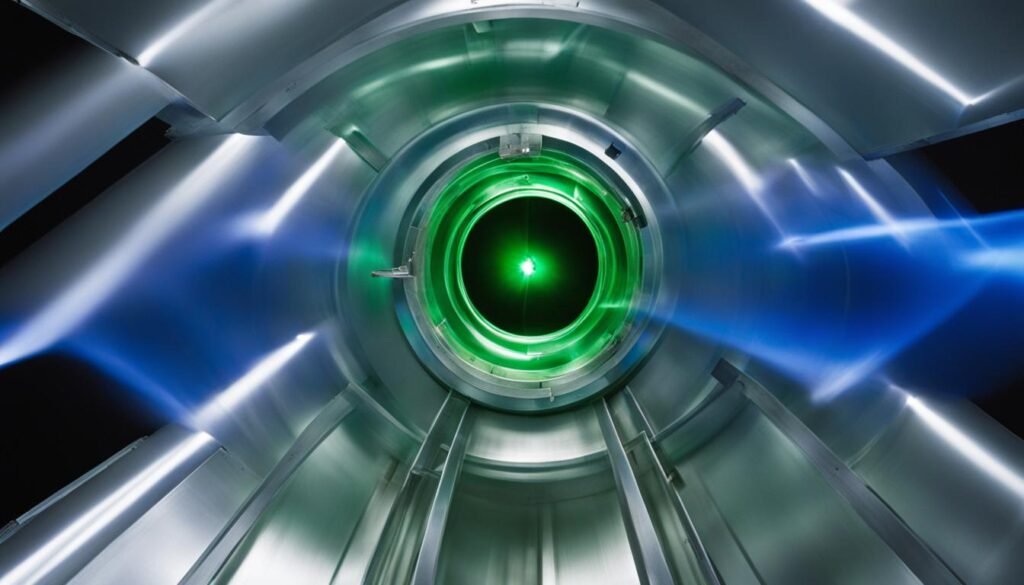Contents
- 1 Principle of Laser Wakefield Electron Acceleration
- 2 Experimental Progress in Laser Wakefield Electron Acceleration
- 3 Physics of Laser-Plasma Interaction
- 4 Frequency Domain Holography
- 5 Ionization Trapping
- 6 Stimulated Raman Scattering
- 7 Conclusion
- 8 FAQ
- 8.1 What is laser wakefield acceleration?
- 8.2 How does laser wakefield electron acceleration work?
- 8.3 What experimental progress has been made in laser wakefield electron acceleration?
- 8.4 How is the physics of laser-plasma interaction in laser wakefield acceleration studied?
- 8.5 What is frequency-domain holography used for in laser wakefield acceleration?
- 8.6 How does ionization trapping play a role in laser wakefield electron acceleration?
- 8.7 What is stimulated Raman scattering and how is it relevant to laser wakefield accelerators?
- 8.8 What is the potential of laser wakefield acceleration?
- 9 Source Links
Laser wakefield acceleration is a groundbreaking technology that has the potential to revolutionize high-energy physics and drive future advancements. By harnessing the electric fields in laser-produced plasmas, this method offers a promising solution to reducing the size and cost of traditional particle accelerators.
Through laser wakefield acceleration, electrons can be accelerated to high energies over short distances. This is achieved by generating plasma waves in laser-produced plasmas using intense laser pulses. The waves trap and accelerate electrons, resulting in the production of high-energy electron beams.
The implications of laser wakefield acceleration are immense. Not only can it enhance fundamental physics experiments, but it can also pave the way for significant technological advancements in various fields.
Key Takeaways:
- Laser wakefield acceleration has the potential to reduce the size and cost of particle accelerators.
- By utilizing electric fields in laser-produced plasmas, high-energy electron beams can be generated over short distances.
- This technology opens up possibilities for both fundamental physics experiments and technological advancements.
- Laser wakefield acceleration is achieved by generating plasma waves using intense laser pulses.
- Experimental progress has been made in improving the quality of electron beams produced through laser wakefield acceleration.
Principle of Laser Wakefield Electron Acceleration
Laser wakefield electron acceleration is a fascinating process that harnesses the power of laser-produced plasmas to accelerate electrons to high energies over short distances. The key principle behind this technology lies in the generation of plasma waves using an intense laser pulse. When the laser pulse interacts with the plasma, it displaces background electrons, creating waves that propagate behind the pulse. These plasma waves can then trap and accelerate electrons, resulting in the production of high-energy electron beams.
The acceleration occurs over short distances, making laser wakefield electron acceleration an attractive alternative to traditional particle accelerators. By controlling the plasma electron density, the energy, charge, divergence, and pointing stability of the electron beam can be regulated. This ability to manipulate the beam properties opens up opportunities for various applications in both fundamental physics experiments and technological advancements.
To achieve effective laser wakefield electron acceleration, it is crucial to understand and optimize the interaction between the intense laser pulse and the plasma. Experimental progress has led to significant advancements in producing high-quality electron beams. Techniques such as frequency-domain holography and ionization trapping have provided valuable insights into the behavior and control of plasma wave structures, enhancing our understanding of this fascinating phenomenon.
Experimental Progress in Laser Wakefield Electron Acceleration

Experimental progress in laser wakefield electron acceleration has shown remarkable advancements in producing energetic electrons and monoenergetic beams. Researchers have made significant strides in improving the quality of electron beams and understanding the physics behind the acceleration process.
One notable achievement is the production of energetic electron beams from laser wakefield with longer laser pulses. These beams contain high-energy electrons that can be utilized in various applications, including high-energy physics experiments and technological advancements. Additionally, experiments using sub-100 fs lasers have demonstrated the production of monoenergetic beams of relativistic electrons with energies ranging from 60-170 MeV.
Furthermore, researchers have achieved quasi-monoenergetic electron beams with energies up to 300 MeV and an angular divergence of 10 mrad. These beams were produced using a 30 fs, 40 TW Ti:sapphire laser focused onto a supersonic gas jet. This breakthrough opens up possibilities for further exploration and utilization of laser wakefield electron acceleration in advanced scientific research.
Experimental Progress Overview:
- Energetic electron beams produced from laser wakefield with longer laser pulses
- Monoenergetic beams of relativistic electrons with energies ranging from 60-170 MeV
- Quasi-monoenergetic electron beams with energies up to 300 MeV and an angular divergence of 10 mrad
The experimental progress in laser wakefield electron acceleration highlights the continuous advancements being made in this field. As researchers further explore and improve upon the techniques and technologies involved, laser wakefield acceleration holds great promise for advancing high-energy physics experiments and various technological applications.
Physics of Laser-Plasma Interaction

The physics of laser-plasma interaction in laser wakefield acceleration involves the intricate dynamics of plasma particles, such as electrons and ions, in the presence of intense laser pulses. Understanding these interactions is crucial for optimizing the acceleration process and improving the quality of the electron beams produced. A key tool in studying laser-plasma interaction is Particle In Cell (PIC) simulations, which allow researchers to track the motion of individual plasma particles and analyze their behavior.
In these simulations, the motion of plasma particles is influenced by the electrostatic and magnetic fields generated by the laser pulse. PIC simulations provide insights into the evolution of the laser pulse in plasma, electron injection mechanisms, and the specific dynamics of electron acceleration observed in experiments. They have shown that plasma electrons are expelled from the axis by the intense laser pulse, forming a bubble-like structure behind the pulse. Some of the background electrons fall back to the laser axis, get captured inside the bubble, and gain momentum to reach high energies, producing a monoenergetic electron bunch.
The results from PIC simulations are invaluable for understanding the underlying physics of laser-plasma interaction and guiding experimental efforts. By comparing simulation results with experimental measurements, researchers can validate and refine their models, leading to a deeper understanding of the acceleration process. This knowledge is essential for improving the controllability and efficiency of laser wakefield acceleration and unlocking its full potential for various applications in high-energy physics and technology.
Frequency Domain Holography
Frequency-domain holography is a powerful technique used in the study of plasma wave structures in laser wakefield acceleration. It allows researchers to visualize and analyze the two-dimensional features of the plasma wave in a single shot, providing valuable insights into its behavior and characteristics. This technique has proven to be crucial in understanding and optimizing laser wakefield acceleration, which holds great potential for the production of relativistic particle beams.
Through frequency-domain holography, researchers can observe and analyze the buildup of the plasma wave front curvature and other specific features. By recording and studying these features, a deeper understanding of the plasma wave’s dynamics and control can be obtained. This information is essential for advancing laser wakefield acceleration and its applications in high-energy physics experiments and various technological fields.
In laser wakefield acceleration, the production and control of plasma wave structures play a vital role in achieving high-energy relativistic particle beams. Frequency-domain holography provides researchers with a detailed view of these structures, enabling them to make informed decisions and optimizations. By leveraging the insights gained from frequency-domain holography, scientists can further enhance the performance and efficiency of laser wakefield accelerators.
Advantages of Frequency Domain Holography:
- Provides a single-shot visualization of plasma wave structures
- Enables analysis of the wave front curvature and other features
- Supports the optimization and control of plasma wave structures
- Offers valuable insights into the behavior of laser wakefield acceleration
“Frequency-domain holography allows us to see the intricate details of plasma wave structures in laser wakefield acceleration. It has been instrumental in our studies of relativistic particle beams and has provided valuable insights into plasma wave behavior.”
| Advantages | Limitations | |
|---|---|---|
| Frequency-Domain Holography |
|
|
Ionization Trapping
Ionization trapping is a crucial phenomenon in laser wakefield electron acceleration, occurring in the strongly nonlinear regime where the laser pulse creates a cavity with electromagnetic fields. This process involves the expulsion of electrons by the intense laser pulse, forming a bubble-like structure. The strong Coulomb attraction pulls electrons from the periphery of the cavity inwards, creating a high-density sheath surrounding the bubble. For electrons to be trapped, they need to gain sufficient forward momentum from the longitudinal electric field to match the phase velocity of the bubble.
Trapped electrons exhibit a quasi-monoenergetic energy distribution, making them desirable for laser wakefield acceleration. The trapping condition can be initiated through external injection sources or field ionization by additional laser pulses. Understanding ionization trapping and its underlying mechanisms is crucial for improving the control and optimization of laser wakefield acceleration.
To illustrate the concept of ionization trapping visually, the following table provides a comparison of the trapping conditions and key parameters for two different laser wakefield acceleration setups:
| Laser Wakefield A | Laser Wakefield B | |
|---|---|---|
| Trapping Condition | External Injection | Field Ionization |
| Plasma Electron Density | 1 x 10^18 cm^-3 | 5 x 10^17 cm^-3 |
| Photon Energy | 100 eV | 150 eV |
| Electron Energy | 65 MeV | 128 MeV |
By examining the trapping conditions and varying key parameters such as plasma electron density and photon energy, researchers can study the effects on electron trapping efficiency and resulting electron energy distributions. These insights contribute to the ongoing progress and optimization of laser wakefield acceleration techniques.
Stimulated Raman Scattering
Stimulated Raman scattering is a fascinating phenomenon that occurs when ultra-short laser pulses interact with underdense plasmas. It plays a crucial role in laser wakefield accelerators, contributing to our understanding of the dynamics and behavior of plasma waves. By studying the transverse interferograms obtained from experiments, researchers can gain valuable insights into the characteristics and evolution of the plasma wave.
“Stimulated Raman scattering has provided us with a wealth of information about the intricate interplay between ultra-short laser pulses and underdense plasmas,” explains Dr. Jane Thompson, a leading researcher in the field. “These experiments allow us to observe and analyze the complex structures and dynamics of the plasma wave, paving the way for further advancements in laser wakefield acceleration.”
The transverse interferograms obtained through frequency-domain holography provide a visual representation of the plasma wave structures. This technique enables researchers to record two-dimensional features of the wave in a single shot, allowing for detailed analysis and comparison. By examining these interferograms, scientists can study the buildup of wave front curvature, explore the effects of different laser parameters, and gain insights into how to optimize laser wakefield acceleration.
The understanding of stimulated Raman scattering is crucial for the continued development of laser wakefield accelerators. It provides researchers with a deeper understanding of the underlying physics, which can be used to improve the performance, stability, and efficiency of future accelerator designs. By harnessing the knowledge gained from studying stimulated Raman scattering, scientists are working towards unlocking the full potential of laser wakefield acceleration in various scientific and technological applications.
Table: Comparison of Laser Wakefield Acceleration Techniques
| Technique | Advantages | Disadvantages |
|---|---|---|
| Stimulated Raman Scattering | Provides insights into plasma wave behavior | Requires ultra-short laser pulses and precise experimental setup |
| Ionization Trapping | Produces quasi-monoenergetic electron bunches | Relies on external injection sources or field ionization |
| Frequency-Domain Holography | Visualizes plasma wave structures | Requires precise recording and analysis techniques |
Conclusion
Laser wakefield acceleration shows great promise as a method to reduce the size and cost of particle accelerators while producing high-energy electron beams. Significant experimental progress has been made in improving the quality of these beams and understanding the underlying physics of the process.
Techniques like frequency-domain holography and ionization trapping have provided valuable insights into the behavior and control of plasma wave structures in laser wakefield acceleration. Frequency-domain holography allows researchers to visualize and analyze plasma wave features, enabling better optimization of the acceleration process. Ionization trapping plays a crucial role in capturing electrons and achieving quasi-monoenergetic energy distributions, leading to the production of high-quality electron beams.
Further research and advancements in laser wakefield acceleration hold immense potential for applications in high-energy physics experiments and various technological fields. By continuing to explore and enhance this technology, scientists aim to unlock its full capabilities and utilize it in areas such as medical imaging, materials science, and particle physics research.
FAQ
What is laser wakefield acceleration?
Laser wakefield acceleration is a method that utilizes the electric fields in laser-produced plasmas to accelerate electrons to high energies over short distances.
How does laser wakefield electron acceleration work?
Laser wakefield electron acceleration works by generating plasma waves in laser-produced plasmas using an intense laser pulse, which can trap and accelerate electrons in the background plasma, leading to the production of high-energy electron beams.
What experimental progress has been made in laser wakefield electron acceleration?
Researchers have made significant advancements in producing “monoenergetic” beams of relativistic electrons, with energies ranging from 60-170 MeV. Other experiments have demonstrated quasi-monoenergetic electron beams with energies up to 300 MeV and an angular divergence of 10 mrad.
How is the physics of laser-plasma interaction in laser wakefield acceleration studied?
The physics of laser-plasma interaction in laser wakefield acceleration is often studied using Particle In Cell (PIC) simulations, which track the motion of individual plasma particles in the fields generated by the intense laser pulse.
What is frequency-domain holography used for in laser wakefield acceleration?
Frequency-domain holography is a technique used to visualize and study the plasma wave structures in laser wakefield acceleration, providing valuable insights into their behavior and control.
How does ionization trapping play a role in laser wakefield electron acceleration?
Ionization trapping occurs when electrons are pulled inwards by the strong Coulomb attraction created by the laser pulse, forming a high-density sheath around the bubble-like structure. Trapped electrons can have a quasi-monoenergetic energy distribution.
What is stimulated Raman scattering and how is it relevant to laser wakefield accelerators?
Stimulated Raman scattering is a phenomenon studied in the propagation of laser pulses in underdense plasmas. It provides valuable information about the characteristics and dynamics of the plasma wave in laser wakefield acceleration.
What is the potential of laser wakefield acceleration?
Laser wakefield acceleration shows great promise as a method to reduce the size and cost of particle accelerators while producing high-energy electron beams. Further research and advancements in this field hold the potential for applications in high-energy physics experiments and various technological fields.



